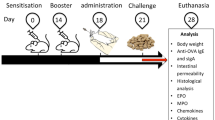Abstract
Some bifidobacteria or lactobacilli exhibit a variety of immunomodulatory effects, such as being anti-inflammatory, increasing IgA secretion, and moderating allergy. We prepared three types of Bifidobacterium components from B. pseudocatenulatum JCM 7041 (Bp) using preparation methods such as sonication, heat treatment, and non-treatment (live Bp). Furthermore, we compared their immunomodulatory effects using in vivo and in vitro immunological bio-assays. We determined immune responses such as cell proliferation and the production of cytokines and IgA in Peyer’s patch cells in vitro following co-culture with bacterial components, and investigated the effects of oral administration of each of them on cytokine and IgA production by Peyer’s patch cells. Live-, ultrasonic treated- and heat-treated Bp exhibited cytokine-inducing and cell proliferation activities. Sonicated Bp in particular showed the greatest immunomodulatory activity in the short term as measured by in vitro and in vivo assays, while heat-treated Bp induced cytokines (e.g. IL-6 and IFN-γ) and IgA production following oral administration for 7 consecutive days. These data showed that Bifidobacterium components prepared by different methods might induce different immune responses. Using scanning electron microscopy we demonstrated that the surface structure of sonicated Bp, which contained more soluble saccharides, was different from other components. These data suggest that the immunomodulatory effect of Bp is dependent upon the bacterial conformation and condition.




Similar content being viewed by others
References
Albrecht I, Tapmeier T, Zimmermann S, Frey M, Heeg K, Dalpke A (2004) Toll-like receptors differentially induce nucleosome remodelling at the IL-12p40 promoter. EMBO Rep 5:172–177 Epub 2004 Jan 2023
Christensen HR, Frokiaer H, Pestka JJ (2002) Lactobacilli differentially modulate expression of cytokines and maturation surface markers in murine dendritic cells. J Immunol 168:171–178
Dennis VA, Jefferson A, Singh SR, Ganapamo F, Philipp MT (2006) Interleukin-10 anti-inflammatory response to Borrelia burgdorferi, the agent of Lyme disease: a possible role for suppressors of cytokine signaling 1 and 3. Infect Immun 74:5780–5789
He F, Morita H, Kubota A, Ouwehand AC, Hosoda M, Hiramatsu M, Kurisaki J (2005) Effect of orally administered non-viable Lactobacillus cells on murine humoral immune responses. Microbiol Immunol 49:993–997
Hosono A, Lee J, Ametani A, Natsume M, Hirayama M, Adachi T, Kaminogawa S (1997) Characterization of a water-soluble polysaccharide fraction with immunopotentiating activity from Bifidobacterium adolescentis M101-4. Biosci Biotechnol Biochem 61:312–316
Hosono A, Lee J, Ametani A, Natsume M, Hirayama M, Adachi T, Kaminogawa S (1998) Comparison of the immunopotentiating activity with structural characteristics among water-solubele polysaccharides isolated from the genus Bifidobacterium. Biosci Microflora 17:97–104
Ibnou-Zekri N, Blum S, Schiffrin EJ, von der Weid T (2003) Divergent patterns of colonization and immune response elicited from two intestinal Lactobacillus strains that display similar properties in vitro. Infect Immun. 71:428–436
Kishi A, Uno K, Matsubara Y, Okuda C, Kishida T (1996) Effect of the oral administration of Lactobacillus brevis subsp. coagulans on interferon-alpha producing capacity in humans. J Am Coll Nutr 15:408–412
Lee J, Ametani A, Enomoto A, Sato Y, Motosima H, Ike F, Kaminogawa S (1993) Screening for the immunopotentiating activity of the immune response by Bifidobacterium adolescentis M101-4. Biosci Biotechnol Biochem 57:2127–2132
Li Y, Qu X, Yang H, Kang L, Xu Y, Bai B, Song W (2005) Bifidobacteria DNA induces murine macrophages activation in vitro. Cell Mol Immunol 2:473–478
Mohamadzadeh M, Olson S, Kalina WV, Ruthel G, Demmin GL, Warfield KL, Bavari S, Klaenhammer TR (2005) Lactobacilli activate human dendritic cells that skew T cells toward T helper 1 polarization. Proc Natl Acad Sci U S A 102:2880–2885 Epub 2005 Feb 2814
Nakanishi Y, Hosono A, Hiramatsu Y, Kimura T, Nakamura R, Kaminogawa S (2005) Characteristic immune response in Peyer’s patch cells induced by oral administration of Bifidobacterium components. Cytotechnology 47:69–77
Newton CA, Perkins I, Widen RH, Friedman H, Klein TW (2007) Role of Toll-like receptor 9 in Legionella pneumophila-induced interleukin-12 p40 production in bone marrow-derived dendritic cells and macrophages from permissive and nonpermissive mice. Infect Immun 75:146–151 Epub 2006 Oct 2023
Ohno H, Tsunemine S, Isa Y, Shimakawa M, Yamamura H (2005) Oral administration of Bifidobacterium bifidum G9-1 suppresses total and antigen specific immunoglobulin E production in mice. Biol Pharm Bull 28:1462–1466
Ratajczak C, Duez C, Grangette C, Pochard P, Tonnel AB, Pestel J (2007) Impact of lactic acid bacteria on dendritic cells from allergic patients in an experimental model of intestinal epithelium. J Biomed Biotechnol 2007:71921 Epub 2007 Feb 71928
Shida K, Takahashi R, Iwadate E, Takamizawa K, Yasui H, Sato T, Habu S, Hachimura S, Kaminogawa S (2002) Lactobacillus casei strain Shirota suppresses serum immunoglobulin E and immunoglobulin G1 responses and systemic anaphylaxis in a food allergy model. Clin Exp Allergy 32:563–570
Uehara A, Sugawara S, Takada H (2002) Priming of human oral epithelial cells by interferon-gamma to secrete cytokines in response to lipopolysaccharides, lipoteichoic acids and peptidoglycans. J Med Microbiol 51:626–634
Whitaker RD, Batt CA (1991) Characterization of the heat shock response in Lactococcus lactis subsp. lactis. Appl Environ Microbiol 57:1408–1412
Acknowledgment
We are grateful to Dr. Taketo Kawarai for his help with the scanning electron microscopy analysis.
Author information
Authors and Affiliations
Corresponding author
Rights and permissions
About this article
Cite this article
Hiramatsu, Y., Hosono, A., Takahashi, K. et al. Bifidobacterium components have immunomodulatory characteristics dependent on the method of preparation. Cytotechnology 55, 79–87 (2007). https://doi.org/10.1007/s10616-007-9105-0
Received:
Accepted:
Published:
Issue Date:
DOI: https://doi.org/10.1007/s10616-007-9105-0




